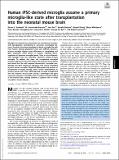Human iPSC-derived microglia assume a primary microglia-like state after transplantation into the neonatal mouse brain
Author(s)
Svoboda, Devon S.; Barrasa, M. Inmaculada; Shu, Jian; Rietjens, Rosalie; Zhang, Shupei; Mitalipova, Maya; Berube, Peter; Fu, Dongdong; Shultz, Leonard D.; Bell, George W.; Jaenisch, Rudolf; ... Show more Show less
DownloadPublished version (3.435Mb)
Terms of use
Metadata
Show full item recordAbstract
Microglia are essential for maintenance of normal brain function, with dysregulation contributing to numerous neurological diseases. Protocols have been developed to derive microglia-like cells from human induced pluripotent stem cells (hiPSCs). However, primary microglia display major differences in morphology and gene expression when grown in culture, including down-regulation of signature microglial genes. Thus, in vitro differentiated microglia may not accurately represent resting primary microglia. To address this issue, we transplanted microglial precursors derived in vitro from hiPSCs into neonatal mouse brains and found that the cells acquired characteristic microglial morphology and gene expression signatures that closely resembled primary human microglia. Single-cell RNA-sequencing analysis of transplanted microglia showed similar cellular heterogeneity as primary human cells. Thus, hiPSCs-derived microglia transplanted into the neonatal mouse brain assume a phenotype and gene expression signature resembling that of resting microglia residing in the human brain, making chimeras a superior tool to study microglia in human disease.
Date issued
2019-11Department
Massachusetts Institute of Technology. Department of BiologyJournal
Proceedings of the National Academy of Sciences
Publisher
Proceedings of the National Academy of Sciences
Citation
Svoboda, Devon S. et al. "Human iPSC-derived microglia assume a primary microglia-like state after transplantation into the neonatal mouse brain." Proceedings of the National Academy of Sciences 116, 50 (November 2019): 25293-25303 © 2019 National Academy of Sciences
Version: Final published version
ISSN
0027-8424
1091-6490